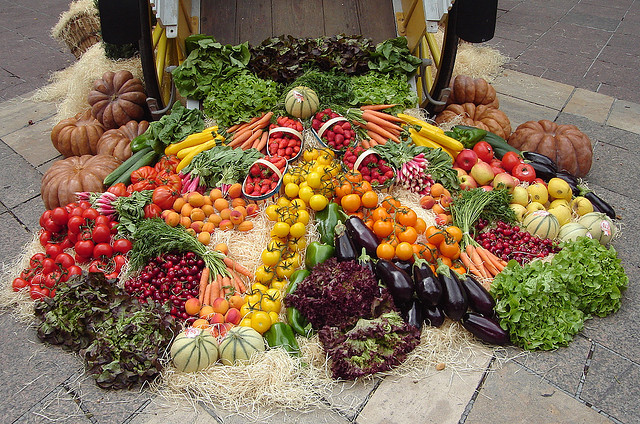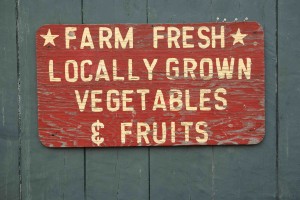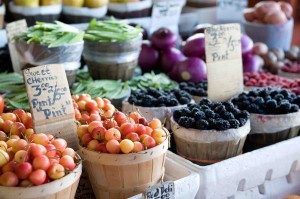Featured image courtesy of val’sphotos.
High-Quality Food – Produce
This post will present my strategies for sourcing high-quality food, focusing on produce, to support a healthy diet based on (mostly) unprocessed plants and animals. I will introduce the range of quality that is present in the modern food system, and how to keep the quality of plants in your diet high while keeping a lookout for tasty deals.
The goal here is to provide a range of options for sourcing your food for different situations. Sometimes you have limited time and need food now, and sometimes you have the time to peruse farmer’s markets and small stores to find some real gems. Some people (like me) will be concerned about the cost, while for others this is less of a problem.
We’re going to be talking about vegetables and fruit. Grains are technically the seeds of plants, and not plants themselves. I suppose fruits technically aren’t plants either, but hey, I’m going to group them in here since I feel like fruit is a worthwhile addition to the diet.
Range in Quality for Produce:
There is a range of quality when it comes to sourcing produce. From most desirable to least desirable:
- Locally grown organic – These are the most likely to be in season, have been picked/harvested very recently, (exception: stored food like apples and cabbage), and will thus be the highest in nutrients and probably the best tasting. The organic label, although pricey, ensures that synthetic pesticides weren’t used and that irradiation was not used to sterilize the food. This is the best stuff, but not always the most economical.
- Locally grown non-organic – These will still be in season and are likely to have been picked or harvested quite recently (same exceptions as above), but have not been certified organic. Synthetic chemicals may or may not have been used. If you can talk to the grocer or, even better, the farmer who grew the plants, then you can get a good idea of the practices used. These can be a great deal if sourced well (see below).
- Non-local organic – Definitely not cheap, and probably not as fresh as can be, but still good quality and absent of synthetic chemicals and irradiation practices.
- Non-local non-organic – These foods might still have some nutritional value, but it’s guaranteed that they were harvested at least a week before you buy them, and that synthetic chemicals and maybe irradiation were used. In a pinch, if washed well, these are still valuable, but just not the best.
*Note: If you’re intent on obtaining produce that isn’t in season, sometimes the best quality comes from the freezer or even a can. The produce used for freezing is frozen at the peak of ripeness, and it retains a good amount (but not all) of the nutrition. Even canning can work reasonably well if the produce isn’t heated too much prior to being canned. Though not ideal (fresh is better), properly frozen or canned produce can outperform 2 week old produce you buy at the grocery store that sits in your fridge for another 2 weeks before you eat it.
Best Places to Go:
- Farmers’ Markets – Here you’ll have a wide selection of locally produced and very fresh food, both organic and non-organic. It may have been picked that very morning. Talk to the farmers and ask how they grew it to see if the cheaper non-organic stuff is as good as the organic. Google “farmer’s markets _______” where the _______is your city to find out when and where they happen.
- Your Own Garden: If you’re starting from scratch, this can be a fair bit of work, but once you have your gardening skills refined, you’ll be getting extremely fresh and high quality food during the summer months. Setting up the garden will cost you money, but I find it very satisfying to grow my own food (the small amount that I do). Something about going to pick it out of the garden and eating it soon after is really exciting to me. I feel very connected to the food.
- Specialized Produce Stores – There’s a whole bunch of different types of these and they focus on produce, so they’re generally better than big-chain grocery stores. These stores will usually have a selection of fresher local plants, and both organic and non-organic options.
- Big-Chain Grocery Stores – There’s a range of these as well. Whole Foods will have the freshest and best selection, but those guys are pretty steep. Other lower-end stores will still have a decent selection, but the produce is usually not as fresh and the vast majority will not be organic or even local (depending on where you live).
How to Keep Produce Costs Down:
- Be Flexible: Learn to enjoy all of nature’s plants! That way, you can always buy whichever ones are the cheapest. It’s easy to get into a routine of always eating the same vegetables, but since prices for a particular vegetable cycle throughout the year, if you’re able to focus on whichever vegetable is at a low point in cost by being flexible, you will save money. This goes hand in hand with the next suggestion.
- Eat seasonally: The big driver for the variation in price of produce is the season. Certain foods are naturally more abundant at certain times of the year, so the price drops. If you mostly eat to match the seasons, you will save money. This means more greens, zucchini, fresh berries and tomatoes in the summer, and more carrots, cabbage, squash and apples in the winter. Imported produce will always be more expensive, but will vary in price throughout the year as well. I confess to occasionally buying red grapes from Chile in the winter as they can be very tasty and reasonably priced.
- Buy Certain Things in Bulk: Plants that store well can be bought in bulk for a much lower overall price. If I shop at the grocery store, I buy onions, carrots, beets, apples, potatoes, sweet potatoes, garlic, and anything else that will last in 2-5 pound bags. You’ll pay less per pound. The downside of this is you get a lot of one type of produce, and you really have to focus on eating it all to get your money’s worth, so you might get tired of it if you don’t have a lot of people to feed. I eat so much and get through it so quick it doesn’t matter.
- Only Buy “The Dirty Dozen” Organic: The Environmental Working Group (EWG) released a list of the 12 produce items that are the most contaminated with pesticides (the “Dirty Dozen”) and the 15 foods with the least contamination (the “Clean Fifteen”). You can save money by realizing that buying conventional non-organic produce from the clean fifteen will result in minimal pesticide exposure. The list can be seen here, where the produce items highest in pesticides are at the top, and the safest options are at the bottom.
Well, that’s all for now. Next post in this series will be all the magnificent ways I now source the best animals and animal products! Stay tuned for that one, for those who are of the omnivorous persuasion.
Please, dearest readers, if you have a comment or question, put it in the comments section below. I’d really appreciate it!
– G




Thanks for another helpful and informative post, Graham. How do you feel about “freshly frozen” fruit and vegetables being perhaps a healthier alternative to imported produce, that’s been on a truck for a while?
Yeah definitely. I reference a study above that shows that frozen, or even canned, produce can outperform older produce that has been sitting around for a while.
Frozen and/or canning is not ideal, but better than month old stuff, for sure!
Thanks for commenting.
Awesome overview! It really makes me think about tomatoes in particular, where the taste is about a zillion times better when purchased in the summer from a local source. Looking forward to your next post!
Thanks Heather! Next post in this series will be on sourcing animal products.